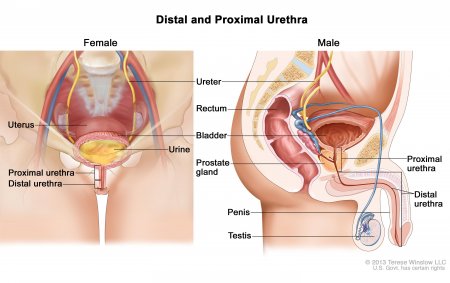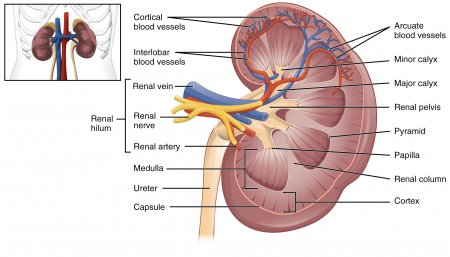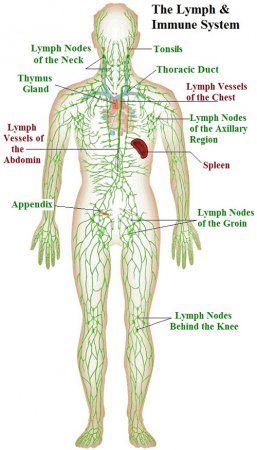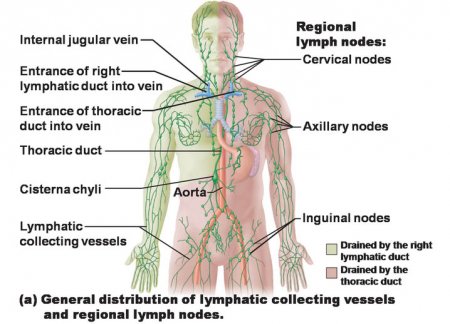The urethra
- Category: Urinary system, The male reproductive system
- Views: 154558
The urethra is a tube that conveys urine from the urinary bladder to the outside of the body. Its wall is lined with mucous membranes and contains a relatively thick layer of smooth muscle tissue. It also contains numerous mucous glands, called urethral glands that secrete mucus into the urethral canal.
The prostate
- Category: Urinary system, The male reproductive system
- Views: 153763
Found only in men, the prostate is a walnut-sized gland that grows throughout a man’s life and may eventually interfere with or prevent urination by blocking the urethra. The prostate makes a significant contribution to the production and ejaculation of semen during sexual intercourse. Prostate cancer is a common disorder of the prostate that often necessitates the surgical removal of the prostate.
The penis
- Category: Urinary system, The male reproductive system
- Views: 161104
The penis is the male external excretory and sex organ. The penis contains the external opening of the urethra, which is used for urination and to deliver semen into the vagina of a female sexual partner. Erectile tissue inside the penis allows the penis to increase in size and become rigid during sexual stimulation. A penis' erection helps to deliver semen deeper into the female reproductive tract during sexual intercourse.
The kidneys
- Category: Urinary system
- Views: 86633
The kidneys are the waste filtering and disposal system of the body. As much as 1/3 of all blood leaving the heart passes into the kidneys to be filtered before flowing to the rest of the body’s tissues. While a person could live with only one functioning kidney, our kidneys are vital organs; the loss of both kidneys would lead to a rapid accumulation of wastes and death within a few days time.
The urinary system of the lower torso
- Category: Urinary system
- Views: 86676
Excess ions and metabolic wastes produced by the body’s cells must be constantly removed from the body to prevent toxic substances from accumulating and poisoning the body. The urinary system of the lower abdomen contains all of the major organs that filter wastes from the blood stream and remove the wastes from the body as urine. These organs include the kidneys, ureters, urinary bladder, and urethra.
A femur cross-section
- Category: Immune and lymphatic systems
- Views: 82280
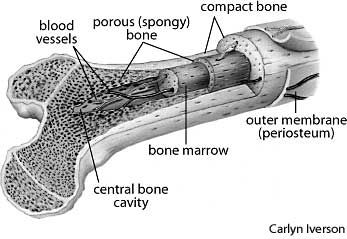
A femur cross-section, along with other living bones, consists of three layers: the periosteum, or outside skin of the bone; the hard compact bone; and the bone marrow. The femur is the thigh bone, the longest bone in the body.
Immune and lymphatic systems of the leg and foot
- Category: Immune and lymphatic systems
- Views: 78080

The primary structures of the lymphatic and immune systems in the lower extremities are the lymph vessels. The large bones of the leg are also important, as these contain bone marrow that produces a large number of lymphocytes.
Immune and lymphatic systems of the arm and hand
- Category: Immune and lymphatic systems
- Views: 83015
The primary structures of the lymphatic and immune systems in the upper extremities are the axillary nodes, which are located just under the armpit (some extend into the chest cavity as well) and the lymph vessels of the arm and hands, which move lymph throughout this region.
The Peyer’s patches
- Category: Immune and lymphatic systems
- Views: 82025

Peyer’s patches are small masses of lymphatic tissue found throughout the ileum region of the small intestine. Also known as aggregated lymphoid nodules, they form an important part of the immune system by monitoring intestinal bacteria populations and preventing the growth of pathogenic bacteria in the intestines.
The immune and lymphatic systems of the lower torso
- Category: Immune and lymphatic systems
- Views: 82074
The immune and lymphatic systems of the lower torso provides many vital functions to the body, including protection of the body from pathogens and the filtration and transportation of lymph, blood, and lipids. Many different structures, from red bone marrow in bones to the spleen, contribute to these processes.
A wide network of dozens of lymph nodes and countless lymphatic vessels spreads throughout the lower torso. This lymphatic network fulfills the important task of returning the interstitial fluid surrounding the tissues of the legs and lower torso to the blood supply. Interstitial fluid is absorbed by tiny lymphatic capillaries in the tissues, forming the fluid known as lymph. Many lymph nodes in the inguinal and iliac regions connect the lymphatic vessels of these regions and filter lymph as it is carried toward the upper torso. Pathogenic components (such as bacteria or viruses), cellular debris, dead cells, and even cancerous tumor cells are trapped by the lymph nodes and prevented from spreading through the body.
